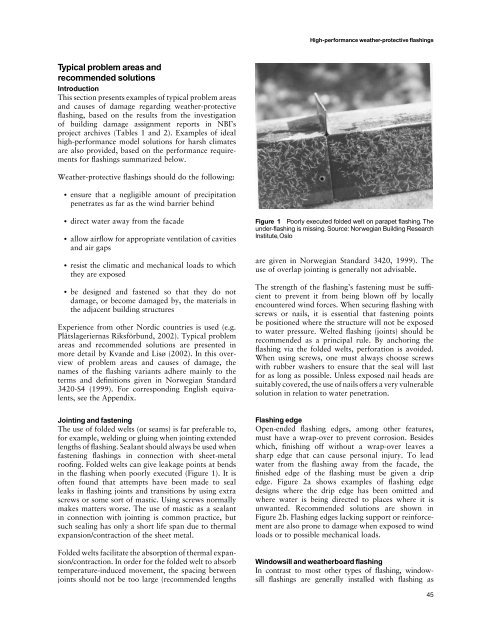Lisø PhD Dissertation Manuscript - NTNU
Lisø PhD Dissertation Manuscript - NTNU
Lisø PhD Dissertation Manuscript - NTNU
You also want an ePaper? Increase the reach of your titles
YUMPU automatically turns print PDFs into web optimized ePapers that Google loves.
Typical problem areas and<br />
recommended solutions<br />
Introduction<br />
This section presents examples of typical problem areas<br />
and causes of damage regarding weather-protective<br />
flashing, based on the results from the investigation<br />
of building damage assignment reports in NBI’s<br />
project archives (Tables 1 and 2). Examples of ideal<br />
high-performance model solutions for harsh climates<br />
are also provided, based on the performance requirements<br />
for flashings summarized below.<br />
Weather-protective flashings should do the following:<br />
. ensure that a negligible amount of precipitation<br />
penetrates as far as the wind barrier behind<br />
. direct water away from the facade<br />
. allow airflow for appropriate ventilation of cavities<br />
and air gaps<br />
. resist the climatic and mechanical loads to which<br />
they are exposed<br />
. be designed and fastened so that they do not<br />
damage, or become damaged by, the materials in<br />
the adjacent building structures<br />
Experience from other Nordic countries is used (e.g.<br />
Pla˚tslageriernas Riksförbund, 2002). Typical problem<br />
areas and recommended solutions are presented in<br />
more detail by Kvande and <strong>Lisø</strong> (2002). In this overview<br />
of problem areas and causes of damage, the<br />
names of the flashing variants adhere mainly to the<br />
terms and definitions given in Norwegian Standard<br />
3420-S4 (1999). For corresponding English equivalents,<br />
see the Appendix.<br />
Jointing and fastening<br />
The use of folded welts (or seams) is far preferable to,<br />
for example, welding or gluing when jointing extended<br />
lengths of flashing. Sealant should always be used when<br />
fastening flashings in connection with sheet-metal<br />
roofing. Folded welts can give leakage points at bends<br />
in the flashing when poorly executed (Figure 1). It is<br />
often found that attempts have been made to seal<br />
leaks in flashing joints and transitions by using extra<br />
screws or some sort of mastic. Using screws normally<br />
makes matters worse. The use of mastic as a sealant<br />
in connection with jointing is common practice, but<br />
such sealing has only a short life span due to thermal<br />
expansion/contraction of the sheet metal.<br />
Folded welts facilitate the absorption of thermal expansion/contraction.<br />
In order for the folded welt to absorb<br />
temperature-induced movement, the spacing between<br />
joints should not be too large (recommended lengths<br />
High-performance weather-protective £ashings<br />
Figure 1 Poorly executed folded welt on parapet £ashing. The<br />
under-£ashing is missing. Source: Norwegian Building Research<br />
Institute,Oslo<br />
are given in Norwegian Standard 3420, 1999). The<br />
use of overlap jointing is generally not advisable.<br />
The strength of the flashing’s fastening must be sufficient<br />
to prevent it from being blown off by locally<br />
encountered wind forces. When securing flashing with<br />
screws or nails, it is essential that fastening points<br />
be positioned where the structure will not be exposed<br />
to water pressure. Welted flashing (joints) should be<br />
recommended as a principal rule. By anchoring the<br />
flashing via the folded welts, perforation is avoided.<br />
When using screws, one must always choose screws<br />
with rubber washers to ensure that the seal will last<br />
for as long as possible. Unless exposed nail heads are<br />
suitably covered, the use of nails offers a very vulnerable<br />
solution in relation to water penetration.<br />
Flashing edge<br />
Open-ended flashing edges, among other features,<br />
must have a wrap-over to prevent corrosion. Besides<br />
which, finishing off without a wrap-over leaves a<br />
sharp edge that can cause personal injury. To lead<br />
water from the flashing away from the facade, the<br />
finished edge of the flashing must be given a drip<br />
edge. Figure 2a shows examples of flashing edge<br />
designs where the drip edge has been omitted and<br />
where water is being directed to places where it is<br />
unwanted. Recommended solutions are shown in<br />
Figure 2b. Flashing edges lacking support or reinforcement<br />
are also prone to damage when exposed to wind<br />
loads or to possible mechanical loads.<br />
Windowsill and weatherboard £ashing<br />
In contrast to most other types of flashing, windowsill<br />
flashings are generally installed with flashing as<br />
45














![Diagnosis and FTC by Prof. Blanke [pdf] - NTNU](https://img.yumpu.com/12483948/1/190x245/diagnosis-and-ftc-by-prof-blanke-pdf-ntnu.jpg?quality=85)

